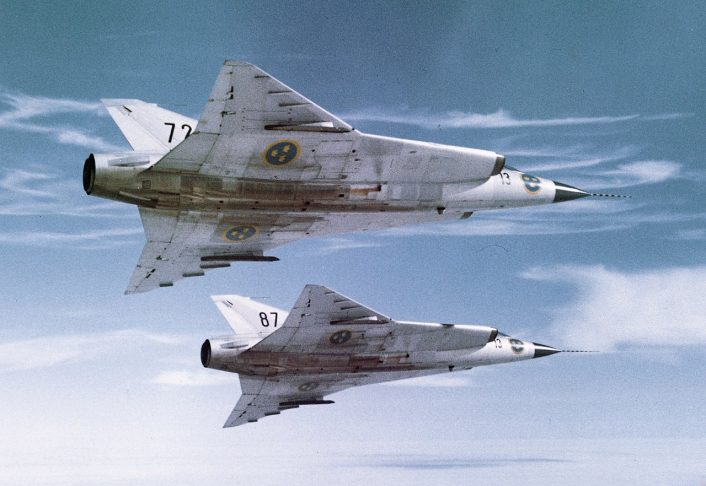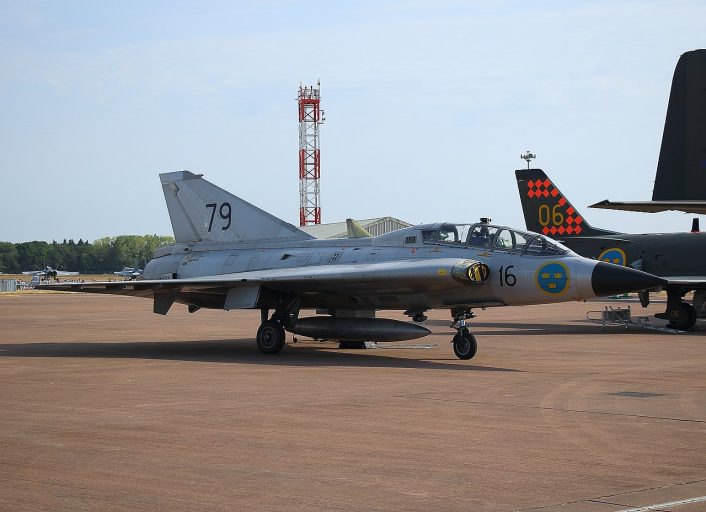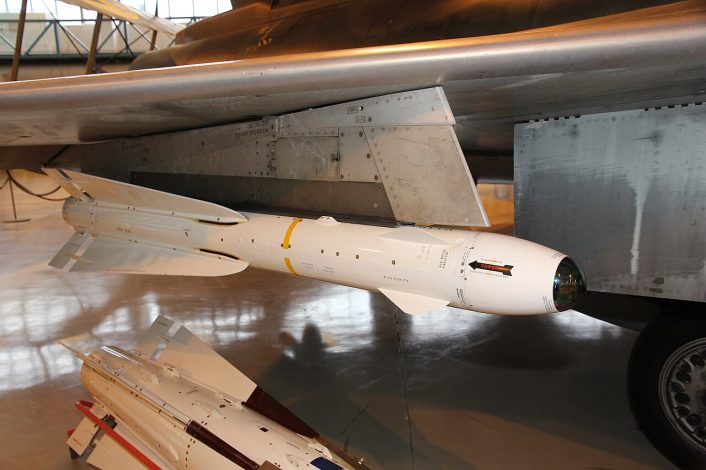One of the most aesthetically pleasing and most recognizable aircraft to the Cold War era, the Saab Draken was the double-delta dragon nobody dared attempt to slay, defending the Scandinavian skies for decades during the Cold War.
The Need and the Solution
Conceived in the late 1940’s as a need for a supersonic interceptor to thwart the threat of high altitude Soviet bombers by the Swedish firm of Svenska Aeroplan Aktiebolaget (SAAB), from a team led by Erik Bratt, the design included a revolutionary but unproven double-delta wing configuration. The aircraft needed to be able to follow the doctrine of the Swedish Air Force (Flygvapnet) of being able to operate not just from air base runways, but be able to be dispersed throughout the country and operate from public roads. It also needed have the ability to be refueled and rearmed quickly.
The double-delta wing design allowed for weapons, fuel, landing gear, and air intakes to be located in the thicker 80 degree swept inner wing, and the thinner outer wings swept at 60 degrees provided the lift for short-field operations and low speed maneuvers, while still allowing the plane to reach supersonic speeds. However this design was new and never tested before.
In order to test the double-delta wing configuration, a test model aircraft was built, the Saab 210. It was powered by the Armstrong Siddeley Adder jet engine and proved the viability of the wing design, flying on Jan. 21, 1952 for the first time by test pilot Bengt Olow. The strange aircraft was tested extensively, with a top speed of around 400 mph.
The Double-Delta Becomes a Reality
The first Draken prototype flew for the first time on Oct. 25, 1955; it was equipped with a license built Rolls Royce Avon Mk 21 engine. In 1956 it had a more powerful Mk 43 engine with afterburner installed. The jet surpassed Mach 1 in level flight on Jan. 26, 1956.
The first production variant was the J 35A. Ninety aircraft of this model was built and the first variant served Sweden from 1960 to 1979. Of this first variant, sixty-five had a Swedish version of the Avon Mk 48A (RM6B) fitted with a Swedish afterburner, the EBK 65. Twenty-five of the A models received the EBK 66 afterburner that was longer and required the rear fuselage to be lengthened. Tests showed the longer fuselage had improved aerodynamics but two small retractable wheels had to be fitted at the rear of the fuselage to prevent it from hitting during touchdown. Twenty-five of the first production A models were eventually converted to two-seat trainers and re-designated the SK 35C.

Improved Versions
Designers had plans for the J 35B on the drawing board before the A model was even a reality. The B model first flew on Nov. 29, 1959. It was the dedicated interceptor version. Incorporating a more advanced engine and afterburner, it also had much needed increase fuel capacity, advanced avionics, and interfaced with Sweden’s advanced air defense system. Seventy-two B model Drakens were completed by March 1963. Armed with two 30mm M55 Aden cannon with ninety rounds of ammo each and two Rb 24 Sidewinder missiles, it could also carry up to thirty-eight 75mm air-to-air all-weather folding-fin rockets. Ground attack rockets could also be added to the mix. The B model was retired in 1976 from Swedish service.
As previously mentioned, the SK 35C trainer was created from existing A model aircraft. The 30mm cannons and radar equipment were removed, and an elevated second seat for the instructor was added behind the pilot seat. The enlarged canopy required affected yaw stability, so two small fins were added under each wing to improve the situation. The C model served until 1998.

The fourth version of the Draken was the J 35D, with improved engine and afterburner; it had greatly increased climb performance and improved acceleration. Internal fuel capacity was improved as well as optional external tanks could be added under the fuselage. The first D prototype model flew in 1960, with 120 production models built, serving Sweden until 1984. Improvements included updated electronics and a new ejection seat.
The S 35E was the reconnaissance version of the Draken. A total of sixty of the version would be built; twenty-eight of those converted from D models, and two were prototypes. The E had radar, cannons, and fire control systems eliminated and replaced with multiple cameras. Five cameras were placed in the nose, which was reshaped to accommodate them, and was easily removed to allow access. Two other cameras were fitted in the gun bays. The type often carried four external fuel tanks.
With a total of two hundred-thirty aircraft produced, the Saab J 35F was the widest produced variant. Improvements included once again a more powerful engine, the new RM6C, new avionics, and new air-to-air missiles.
These missiles were designated the Rb 27 and Rb 28, and were Swedish versions of the Hughes AIM-4 Falcon American missile. The F also only carried one cannon and 90 rounds of ammunition, as well as the capability of carrying the Rb 24 (Sidewinder) missiles. The F model could reach speeds up to Mach 2.0. It had a range was over 2,000 miles with maximum extended fuel tanks, and the service ceiling of over 65,000 ft. The J 35F served Sweden until 1989.

The final and ultimate version of the Draken was the J 35J model. Sixty-seven of the F models were modified with improved radar, fire control systems, navigation systems, new cockpit electronics, and two new stores pylons added. The wings were strengthened and the plane could now carry more ordinance and external tanks. A more powerful engine was included in the upgrade to assist in getting the extra weight off the ground.
J 35J Draken’s served until retired in December 1998, with the last flight in Jan. 1999. It had been retained in service because it never really became obsolete and still had potential to be upgraded. The J served at the end as operational training support for other foreign users of the aircraft.
Accomplishments
The Draken and its state of the art performance and ability to do many jobs while accepting upgrades with ease kept the skies over Scandinavia peaceful during the height of the Cold War. Drakens performed the roles of interceptor, ground attack, fighter, reconnaissance, and trainer. The jet out-performed almost all of its contemporaries, and was vastly superior to its Soviet counterparts. It was the first truly supersonic combat aircraft to be deployed in Western Europe, the first with double delta wings, and because of those double delta wings, it was the first aircraft known to be able to perform the “Cobra” maneuver.
The Draken also found homes in the air forces of Finland (some license assembled by Valmet), Austria, and Denmark. Austria was the last to retire the jet, doing so in 2005. The United States operated six-J 35’s at the National Test Pilot School in Mojave, California until 2009.

